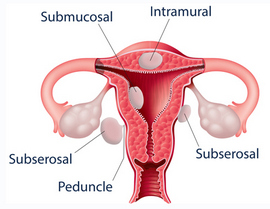Uterine Fibroids Larger sizes
Definition
Uterine fibroids are the most common pelvic monoclonal neoplasm’s (tumors arising from a single smooth muscle cell) that tend to increase in size during the reproductive years and regress or shrink after menopause because fibroids are estrogen dependent tumors.
African-American women are more likely to get fibroids than women of other races. It is estimated that 50 percent of African-American women and 25 percent of white American women will develop fibroids by age 50.
Fibroids are usually multiple neoplasms arising from a single smooth muscle cell.
Fibroids can be divided into four different types:
The common four types of fibroids are pedunculated, submucosal, intramural, and subserosal; however, fibroids may occur intraligamentous (in the broad ligaments) or in the uterine tubes, less commonly fibroids may occur in the cervix (5% of all cases).
Degenerative changes in uterine fibroids occur when a fibroid grows fast that the central areas may not receive an adequate blood supply. The common types of degeneration are hyaline, myxomatous, cystic, fatty, calcific, necrotic or red (occurs most often during pregnancy). Although patients are often concerned about cancer evolution in fibroids, sarcomatous change within fibroids is extremely rare.
Symptoms
- Abdominal pressure related to increasing tumor size, contractile pain in the lower quadrant of the abdomen
- Heavy bleeding and long lasting menstruation
- Depression
- Weight gain may be noticed.
Causes
Fibroids are monoclonal benign tumors that arise from smooth muscle cells with estrogen receptors (ER), these tumors tend to increase in size during the reproductive years (13-49) since they depend on estrogen for their growth and regress after menopause. Larger fibroids are more likely to undergo degenerative changes. Benign degeneration is often followed by calcification where they calcify and acquire a hyaline, myxomatous or cystic appearance, due to fibroid degeneration.
Treatment
Classical treatment
Hormone replacement therapy (femoston, kliogest..)
Alternative treatment
>>> Natural treatment for uterine fibroids
Next steps management
Physical examination, pelvic ultrasound, hysteroscopy and separate diagnostic curettage.
Surgery and fibroid removal is indicated if:
- Rapidly growing fibroids (intramural, subserousal, submucosal, tubal, cervical, intraligamentous), especially in postmenopausal women.
- Suspicion of malignancy
- Malnutrition myoma node
- Bleeding
- Infertility
- Dysfunction of adjacent organs because of the large tumor size.
Verified by: Dr.Diab (January 7, 2017)
Citation: Dr.Diab. (January 7, 2017). Uterine Fibroids. Medcoi Journal of Medicine, 6(2). urn:medcoi:article15560.














There are no comments yet
Or use one of these social networks